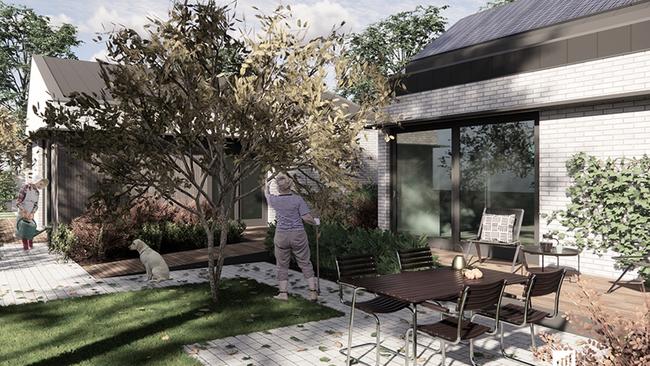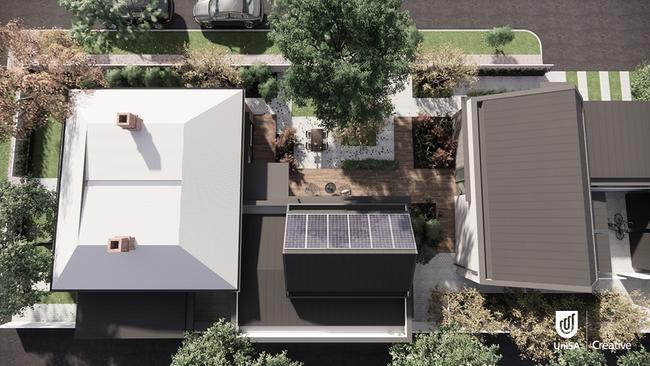Future Living code amendment housing plan to allow co-located living in six SA council areas
Six different councils in Adelaide would be able to have “co-located” living under plans one expert has heralded as “nationally significant” reforms.
SA News
Don't miss out on the headlines from SA News. Followed categories will be added to My News.
Existing, older homes would be expanded and turned into multi-housing, ‘co-located’ dwellings in six key councils under what an expert called a “smart, creative” plan to tackle SA’s housing crisis.
The Future Living proposal means current homes could be expanded or altered to create multiple homes with shared garden spaces, laundries or common areas, controlled by strict bylaws under a community title.
People would own their own homes and properties or they could be rented out.
A larger, older house in the Burnside or Unley council area could be expanded to become three homes to three older couples who want to downsize, with a smaller, shared garden area.

The draft code amendment by the State Planning Commission – created over three years with UniSA architect Dr Damian Madigan – would also apply initially to the Walkerville, Prospect, Campbelltown and Alexandrina council area on the Fleurieu but could expand.
It encourages existing homes to be retained, altered, and extended to create ‘co-located’ housing, rather than bulldozing a house, trees or established gardens for subdivision.
It also aims to create community through shared open space rather than small private gardens.
Commission chair Craig Holden said this “new form of communal living” – which occurs in Scandinavian countries and in Toronto – allowed people to “age in place”.
It alleviated community fears about the loss of the streetscape’s character, gardens and trees but provided housing diversity, he said.
Rules ensure each home – which could be bought and sold separately – had a private courtyard and access to the shared garden.
“We retain the original building, you keep the four main rooms of a villa and that becomes a one- or two-bedroom house. You can then provide another single-bedroom house or two behind it with a shared garden,” Mr Holden said.
“It would be a community title so there are bylaws about behaviours … how you live, share the communal gardens, retain the established trees, to ensure the intention continues over time.
“There would be no more extra built form than if you bought a house in an established street and did an addition out the back with a swimming pool.”
Planning Minister Nick Champion said all homes on one block would be of a similar stature – removing the difference of a house and a granny flat.


SA planning and housing expert Michael Lennon called it a “nationally significant proposal, smart and creative”.
Currently, planning laws do not allow occupation by multiple households on a block, he said.
“This addresses a number of things simultaneously – you’ve got under under-utilisation, families able to cohabitate, renters being able to access more supply, and isolated people can get company and income.
“All the while you’re not disrupting the character of the streets in the neighbourhood.”
“While everyone is focused on land supply and new homes, we have hundreds of thousands of under-utilised homes and empty bedrooms, which could accommodate people and families better.”
Mr Champion said creating a diverse SA housing market was essential in tackling the crisis.
“This code amendment has the potential to create more housing options, while still retaining the character and heritage of existing streetscapes,” he said.

“This is an option which could allow more affordable homes to be built for people looking to downsize or age in place.”
There are three requirements for homes to be turned into co-located housing: that the existing home facing the street is retained and included in the development; new dwellings are created by internal alterations, extensions, or as new detached backyard homes – all as standard low-rise homes; and the houses are arranged around backyard open space.
A City of Unley spokesperson said the council was reviewing the draft Future Living Code Amendment but is open to changes that encouraged keepingheritage homes and preserving the character of neighbourhoods and suburbs while providing a greater range of housing opportunities to meet the diverse needs of our communities.
Alan Harvey, acting CEO of Alexandrina Council said the council asked to be included because “finding options to increase housing diversity and housing affordability in our region is important for our community”.
“However, we want to hear what our community’s views are on the changes proposed by the Code Amendment.”
Burnside Council CEO Chris Cowley encouraged residents to have their say and said council will also consider the Code Amendment.
Prospect Mayor Matt Larwood said his council had long advocated for policy reform to support greater housing choice and protecting heritage and character homes.
“We are particularly interested in the potential for co-housing within our community,” he said.
“We look forward to closely examining the draft policy in detail during the consultation period to ensure it will deliver successfully upon its objectives in practice.”
The draft rules “complement and add to existing rules, such as building height limits”, Mr Holden said.
Public feedback is now being sought at the YourSAy website at www.yoursay.sa.gov.au/future-living.






